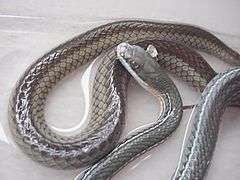Masticophis schotti
Masticophis schotti, commonly known as Schott's whip snake, is a species of snake in the family Colubridae.
| Masticophis schotti | |
|---|---|
 | |
| Masticophis schotti schotti | |
| Scientific classification | |
| Kingdom: | Animalia |
| Phylum: | Chordata |
| Class: | Reptilia |
| Order: | Squamata |
| Suborder: | Serpentes |
| Family: | Colubridae |
| Genus: | Masticophis |
| Species: | M. schotti |
| Binomial name | |
| Masticophis schotti | |
| Synonyms | |
| |
Geographic range
The species is found in United States in Texas and in western Mexico.[2] It lives up to an altitude of 2300 meters.[1]
Subspecies
- Masticophis schotti ruthveni Ortenburger, 1923 – Ruthven's whip snake
- Masticophis schotti schotti Baird & Girard, 1853 – Schott's whip snake
Etymology
Its species name was given to it in honor of Arthur Schott.[2] The subspecies Masticophis schotti ruthveni is named in honor of Alexander Grant Ruthven.
gollark: Yes, I'm using it.
gollark: Which I'm unhappy about (we need more than two browser engines, really).
gollark: They switched Edge to using Chromium instead of their own HTML stuff.
gollark: I think I have Orbot (Tor client) installed on my phone still, but mostly I just use my mobile network provider. They're awful in their own way, though (like I said, blocking archive.org).
gollark: What is this "government class"?
References
- Lavin, P.; Hammerson, G.A. & Mendoza-Quijano, F. "Masticophis schotti". IUCN Red List of Threatened Species. 2013.
- Masticophis schotti at the Reptarium.cz Reptile Database. Accessed 2020-06-06.
Original publications
- Baird & Girard, 1853 : Catalogue of North American Reptiles in the Museum of the Smithsonian Institution. Part 1.-Serpents. Smithsonian Institution, Washington, p. 1-172 (Full text).
- Ortenburger, 1923 : A note on the genera Coluber and Masticophis and a description of a new species of Masticophis. Occasional papers of the Museum of Zoology, University of Michigan, No. 139, p. 1-14 (Full text).
- Smith, 1941 : Notes on Mexican snakes of the genus Masticophis. Journal of the Washington Academy of Sciences, vol. 31, No. 9, p. 388-398 (Full text).
This article is issued from Wikipedia. The text is licensed under Creative Commons - Attribution - Sharealike. Additional terms may apply for the media files.
